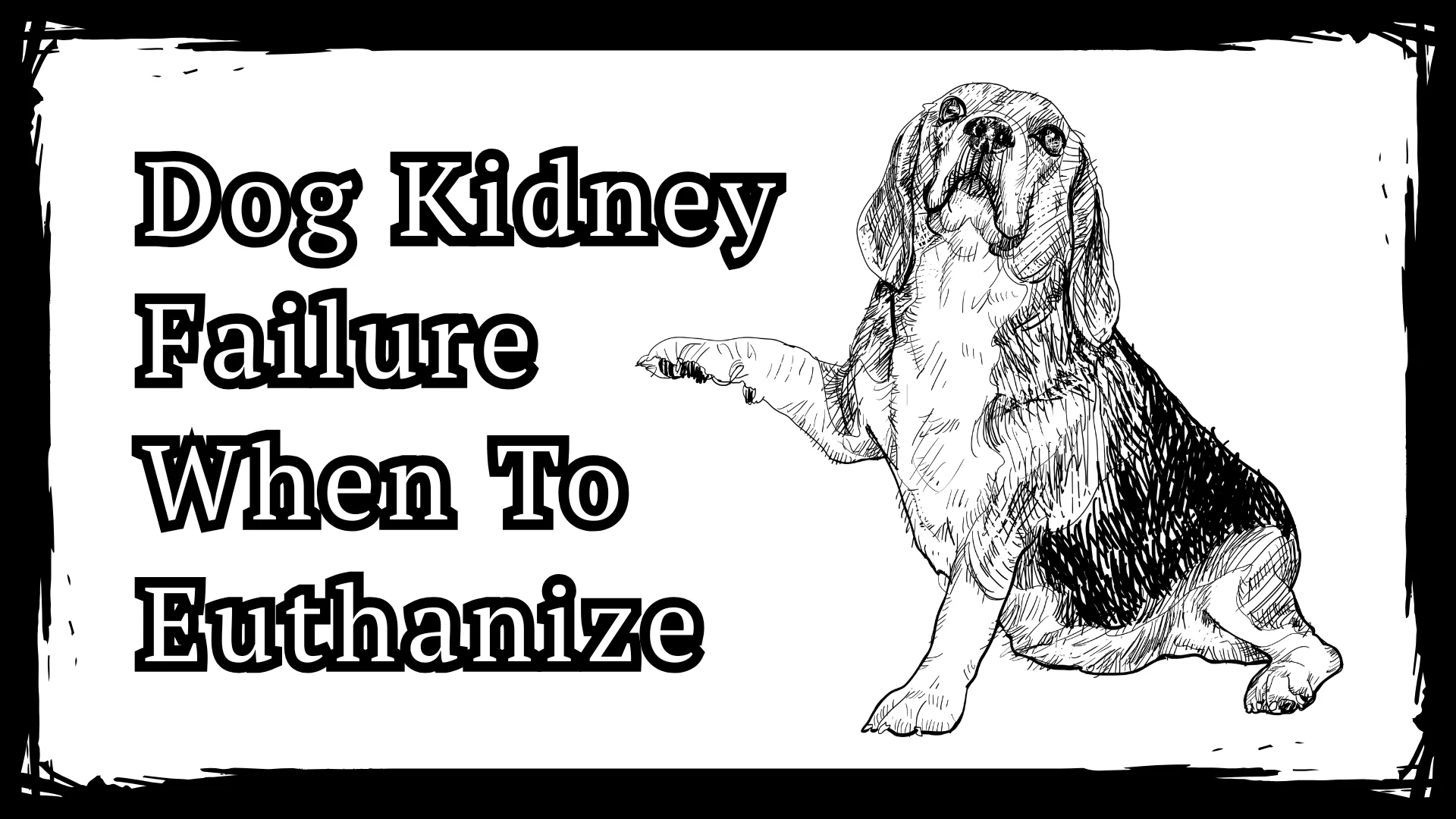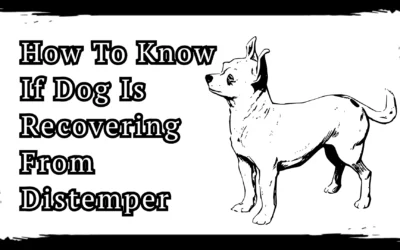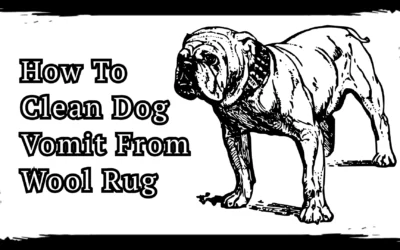Dog Kidney Failure: When To Euthanize? As this insidious disease progresses, one of the most agonizing questions emerges: “When is it time?” Understanding the disease, recognizing the signs of decline, and knowing how to assess your dog’s quality of life are crucial for making this profoundly difficult decision with love and compassion.
Euthanize a dog with kidney failure (CKD/renal failure) when they persistently refuse food/water, experience uncontrollable vomiting or severe weakness, and show no joy in life. These signs indicate irreversible suffering due to kidney issues.
This comprehensive guide explores canine kidney failure, its impact, management options, and the sensitive considerations surrounding euthanasia.
Understanding Kidney Failure In Dogs
Kidney failure (Renal failure) occurs when the kidneys lose their ability to effectively filter waste products from the blood, maintain fluid and electrolyte balance, and produce essential hormones. There are two main types:
- Acute Kidney Injury (AKI): A sudden, often severe decline in kidney function, usually caused by toxins (like antifreeze, grapes/raisins, certain medications), infections, dehydration, or trauma. AKI can be reversible with aggressive, immediate treatment if caught early.
- Chronic Kidney Disease (CKD): A long-term, progressive deterioration of kidney function over months or years. It’s more common, especially in older dogs, and is irreversible. Management focuses on slowing progression and maintaining quality of life.
The Kidneys—What Do They Do?
- Filtering Waste: Removing toxins and metabolic byproducts (like urea and creatinine) from the blood.
- Regulating Fluids: Maintaining proper hydration by adjusting urine concentration.
- Balancing Electrolytes: Controlling levels of sodium, potassium, calcium, and phosphorus.
- Regulating Blood Pressure: Releasing hormones (renin) that influence blood pressure.
- Producing Hormones: Creating erythropoietin (stimulates RBCs production) and calcitriol (active form of Vitamin D for bone health).
An Overview Of Kidney Disease In Dogs
Chronic Kidney Disease (CKD) is one of the most common diseases affecting senior dogs. As nephrons (the kidney’s functional units) become damaged and die, the remaining nephrons work harder to compensate. This works for a while, but eventually, the workload overwhelms them, leading to a buildup of toxins in the blood (azotemia) and the clinical signs we recognize as kidney failure.
The disease is staged (IRIS Staging System) based on blood tests (creatinine, SDMA), urine tests (protein levels), and blood pressure, guiding treatment and prognosis.
Breeds More Susceptible To Kidney Failure
- Cocker Spaniels: Prone to glomerulonephritis (inflammation of kidney filters).
- Bull Terriers: Hereditary nephritis leading to early kidney failure.
- Samoyeds: Hereditary glomerulopathy.
- German Shepherds: Familial glomerulonephritis.
- Shar-Peis: Prone to amyloidosis (abnormal protein deposits in the kidneys).
- Doberman Pinschers: Familial glomerulonephropathy.
- Lhasa Apsos, Shih Tzus: Increased risk of kidney stones contributing to disease.
- Cairn Terriers, Beagles: Also show higher incidence.
Causes And Symptoms Of Kidney Failure
Causes Of Kidney Failure In Dogs
- Chronic Causes (CKD): Age-related degeneration, congenital disabilities, infections (e.g., pyelonephritis), kidney stones (nephrolithiasis), high blood pressure, glomerular disease, cancer, amyloidosis, breed predispositions.
- Acute Causes (AKI): Ingestion of toxins (antifreeze, grapes/raisins, lilies, certain human medications like NSAIDs), severe infections (e.g., leptospirosis), urinary blockages, severe dehydration, heatstroke, snake venom, and heart failure.
Identifying Symptoms Of Kidney Failure
Symptoms often appear subtly and worsen as the disease progresses. Early detection is key!
Also Read: Should I Put My Dog Down If He Is Still Eating
Symptoms Of Kidney Disease
- Increased Thirst (Polydipsia) & Urination (Polyuria): The kidneys lose their ability to concentrate urine, leading to excessive water intake and volume of dilute urine.
- Decreased Appetite: Toxin buildup causes nausea and a metallic taste.
- Weight Loss: Due to reduced appetite and muscle wasting.
- Lethargy & Weakness: Toxins sap energy; anemia (from reduced erythropoietin) compounds this.
- Vomiting & Diarrhea: Common due to uremic toxins irritating the stomach and gut.
- Bad Breath (Uremic Breath): A distinct ammonia-like odor caused by toxin buildup.
- Poor Coat Condition: Dry, brittle, unkempt fur.
- Mouth Ulcers: Uremic toxins can cause painful sores in the mouth.
- Pale Gums: Indicative of anemia.
- Hypertension: Can lead to sudden blindness (retinal detachment) or neurological signs.
The Pain Associated With Kidney Failure
The pain associated with kidney failure itself isn’t typically described as acutely painful like a broken bone, but it causes significant discomfort and distress:
- Nausea: Constant or intermittent queasiness.
- Mouth Pain: Ulcers make eating and drinking painful.
- Dehydration: Can cause headaches and general malaise.
- Muscle Cramps/Twitching: Electrolyte imbalances can cause this.
- Overall Malaise: The constant feeling of being unwell.
Consequences Of Untreated Kidney Issues
Without intervention, kidney failure is fatal. Toxin levels rise uncontrollably, leading to severe dehydration, intractable vomiting and diarrhea, profound weakness, seizures, coma, and ultimately, death. This process is distressing and painful for the dog.
Treatment Options And Management
While CKD is not curable, treatment focuses on slowing progression and maximizing quality of life. AKI requires aggressive therapy to reverse the damage, if possible.
Available Treatments
- Fluid Therapy: Subcutaneous (under the skin) or intravenous fluids are the cornerstone of treatment for both AKI and CKD, combating dehydration and helping flush toxins.
- Dietary Management: Prescription kidney diets (e.g., Hill’s k/d, Royal Canin Renal, Purina NF) are VITAL. They are:
- Low in Phosphorus: High phosphorus accelerates kidney damage.
- Low in Protein (but High Quality): Reduces nitrogenous waste products.
- Controlled Sodium: Helps manage blood pressure.
- High in Omega-3 Fatty Acids: They have anti-inflammatory effects.
- Appetite-Stimulating: Palatable to encourage eating.
- Phosphate Binders: Medications (e.g., aluminum hydroxide, calcium acetate, lanthanum carbonate) given with food to prevent phosphorus absorption from the diet.
- Anti-Nausea/Anti-Vomiting Medications: (e.g., Cerenia, Ondansetron, Famotidine/Pepcid) to control GI upset.
- Appetite Stimulants: (e.g., Mirtazapine, Entyce) to encourage eating.
- Blood Pressure Medications: (e.g., Amlodipine, Telmisartan) if hypertension is present.
- Potassium Supplementation: If blood potassium is low (hypokalemia).
- Erythropoiesis-Stimulating Agents (ESAs): (e.g., Darbepoetin) to treat severe anemia caused by a lack of erythropoietin (costly and requires careful monitoring).
- Treatment of Underlying Causes: Antibiotics for infections, surgery for blockages, etc.
Treatment For Acute Kidney Disease
Treatment for acute kidney disease focuses on intensive care: aggressive IV fluids, specific antidotes if available (e.g., for antifreeze poisoning), managing complications (electrolytes, nausea, pain), and supporting kidney function while they recover. Hospitalization is often necessary.
Treatment For Chronic Kidney Disease
Lifelong management centered on home care:
- Strict Adherence to Kidney Diet: Non-negotiable.
- Regular Subcutaneous Fluids: Often administered at home by owners.
- Consistent Medication Schedule: Phosphate binders, anti-nausea, BP meds, etc.
- Regular Veterinary Monitoring: Blood tests, urine tests, and blood pressure checks to adjust treatment.
Nutritional Strategy
The prescription kidney diet is arguably the most important long-term management tool for CKD. Transitioning to it should be done gradually and with veterinary guidance. Finding a formula your dog will accept is crucial – sometimes offering warmed food, hand-feeding, or using appetite stimulants temporarily can help.
Medication
A multi-drug approach is common. Consistency is key. Never stop medications without consulting your vet.
Read More: How Much Baby Aspirin Can I Give My Dog
Supporting Your Dog At Home
At-Home Methods For Improving Quality Of Life
- Easy Access to Fresh Water: Place multiple bowls around the house. Consider pet water fountains to encourage drinking.
- Frequent Potty Breaks: Be prepared for accidents as urination needs increase.
- Comfortable Resting Areas: Provide soft, easily accessible beds. Use waterproof pads if needed.
Read More: What Home Remedy Can I Give My Dog For Coughing
Reduce The Stress Of Increased Urination
More frequent walks, Puppy pads near exits or in easy-to-clean areas, Dog diapers (if tolerated), Patience and understanding – never punish accidents.
Find Appealing Foods
Warm the food slightly (enhances aroma), Hand-feed small amounts, try different textures (pate, stew, dry kibble) of the prescription diet, consult your vet about safe, low-phosphorus/low-protein toppers (tiny amounts of boiled chicken breast, egg white, low-sodium broth approved by your vet), and use appetite stimulants as prescribed.
Soothe Your Dog’s Sore Mouth
Ask your vet about oral rinses or gels safe for kidney patients. Offer soft food, and ensure fresh water is always available to rinse the mouth.
Comfort Measures For Affected Dogs
Gentle grooming, quiet and calm environment, Gentle massage if enjoyed, maintaining routines as much as possible, Lots of love and reassurance.
Preventative Measures For Kidney Health
- Annual Wellness Exams: Blood and urine tests are essential for early detection, especially in senior dogs.
- Constant Access to Fresh Water.
- Avoid Toxins: Keep antifreeze, grapes/raisins, lilies, human medications (especially NSAIDs like ibuprofen), and toxic plants securely away.
- Prompt Treatment of UTIs and Dental Disease: Can spread to the kidneys.
- Healthy Diet & Weight: Obesity strains the body.
- Management: Like heart disease or high blood pressure.
Prognosis And What To Expect
Life Expectancy And Prognosis
Prognosis varies drastically depending on:
- Type: AKI has a more variable prognosis – some dogs recover fully, others progress to CKD, or don’t survive. CKD prognosis depends on the stage at diagnosis and response to treatment.
- Stage: Early-stage CKD dogs (IRIS Stage 1-2) often live years with good management. Late-stage (IRIS Stage 3-4) prognosis is more guarded, often months to maybe a year or two with intensive care.
- Underlying Cause: Some causes are more manageable than others.
- Owner Commitment: Consistent home care is paramount.
- Complications: The Presence of severe hypertension, proteinuria, or anemia worsens prognosis.
- Overall Health: Other diseases impact resilience.
Prognosis For Kidney Failure
There is no cure for CKD. The goal is disease management, not reversal. With dedicated care, many dogs maintain a good quality of life for a significant period after diagnosis. However, the disease will progress over time.
Recognizing The End-Stage Symptoms
As kidney failure reaches its final stage, quality of life typically declines significantly. Watch for:
Changes During The Last Days Of a Dog With Kidney Failure
- Severe Lethargy: Little to no interest in surroundings; sleeping excessively.
- Decreased Appetite to Complete Anorexia: Refusing food and water entirely.
- Behavior Changes: Withdrawal, confusion, restlessness, or seeking unusual hiding spots.
- Intractable Vomiting and/or Diarrhea: Unable to keep anything down.
- Extreme Weakness: Difficulty standing or walking; Dog Kidney Failure Weak Legs is a common sign of severe weakness and neurological impact of toxins.
- Incontinence: Loss of bladder/bowel control.
- Labored Breathing: Due to severe anemia, dehydration, or acidosis.
- Twitching/Seizures: Caused by severe electrolyte imbalances and toxin overload.
- Significant Weight Loss and Muscle Wasting.
- Very Bad Odor: Strong uremic smell from breath and body.
- Cold Extremities: Poor circulation.
Dog Kidney Failure: When To Euthanize

Dog Kidney Failure Weak Legs
Weak legs in dogs with kidney failure often signal muscle wasting, electrolyte imbalances, or toxin buildup in the body. As the kidneys lose function, waste products accumulate in the bloodstream, affecting the muscles and nerves, leading to shakiness, unsteadiness, or collapse. This symptom may indicate the disease has progressed to an advanced or end stage, and it’s important to consult your vet about quality of life concerns and next steps.
Last Days Of Dog With Kidney Failure Vomiting
Last Days Of Dog With Kidney Failure: Vomiting and Last Days Of Dog With Kidney Failure Symptoms like severe lethargy and anorexia are strong signals that the end is near and suffering is escalating.
Also Read: Can I Give My Dog Gatorade For Vomiting
Last Days Of Dog With Kidney Failure Symptoms
Last Days Of Dog With Kidney Failure Symptoms and Last Days Of Dog With Kidney Failure: Vomiting, such as severe lethargy, and anorexia, are strong signals that the end is near and suffering is escalating.
Making The Decision To Euthanize
Making The Decision For Euthanasia
This is one of the hardest decisions a pet owner will ever make. It’s an act of profound love and responsibility, preventing unnecessary suffering. Consider:
- Quality of Life Scales: Use tools like the HHHHHMM Scale (Hurt, Hunger, Hydration, Hygiene, Happiness, Mobility, More Good Days Than Bad) or our free dog Quality of Life Scale to assess your dog’s daily experience. Track it over several days.
- “The List”: What are your dog’s 5 favorite things? When they can no longer enjoy any of them or have more bad days than good, it’s a strong indicator.
- Consult Your Veterinarian: They understand the disease progression and your dog’s specific case. Ask for their honest assessment of prognosis, pain levels, and whether they feel euthanasia is a reasonable option. “Making The Decision To Euthanize Your Dog With Kidney Failure” should be done with your vet’s guidance, not in isolation.
- Listen to Your Dog: Observe them closely. Are they withdrawn? Struggling? Do their eyes seem tired? Trust your intuition, as who knows best.
Making The Decision To Euthanize Your Dog With Kidney Failure
Deciding to euthanize your dog with kidney failure should be done with your vet’s guidance, not in isolation.
What Your Dog Wants You To Know About Saying Goodbye
Your dog relies on you completely. They don’t fear death as humans do, but they experience pain, nausea, and distress. Choosing euthanasia before their suffering becomes unbearable is the ultimate gift of love and loyalty. They trust you to make the right decision for them, even when it breaks your heart.
Can a Dog Die Naturally From Kidney Failure?
Yes, a dog can die naturally from the complications of end-stage kidney failure. However, this process is often prolonged and involves significant suffering – severe nausea, dehydration, weakness, potential neurological symptoms (twitching, seizures), and distress. Euthanasia provides a peaceful, painless, and dignified passing, sparing them this traumatic natural death.
Special Cases: Euthanasia By Age
Senior Dog Kidney Failure: When To Euthanize?
Assess quality of life. Senior dogs often have less reserve to cope with the demands of advanced CKD treatment (like frequent fluids, vet visits). They may also have concurrent age-related conditions (arthritis, cognitive decline) that compound their discomfort. Be realistic about their ability to tolerate treatment and enjoy life.
Must Read: When Should I Put My Dog Down
Old Dog Kidney Failure: When To Euthanize?
Sometimes, for a very old dog with multiple issues and advanced CKD, choosing euthanasia sooner rather than subjecting them to intensive management that offers little quality time is the kinder choice.
Older Dog Kidney Failure: When To Euthanize?
Assess quality of life. Sometimes, for an older dog with multiple issues and advanced AKD or CKD, choosing euthanasia sooner rather than subjecting them to intensive management that offers little quality time is the kinder choice.
Coping With The Loss
Take Care Of Yourself Too
- Acknowledge Your Grief: Don’t minimize the feelings. Cry, talk, write.
- Seek Support: Talk to understanding friends, family, or pet loss support groups (online or in-person).
- Memorialize Your Pet: Create a photo album, plant a tree, write a letter, or donate in their name.
- Be Kind to Yourself: Guilt is common, but remember: you acted out of love to prevent suffering. You gave them a peaceful end.
Resources To Help You On This Journey
- Association for Pet Loss and Bereavement (APLB): (aplb.org) – Resources, chat rooms, support.
- Lap of Love: (lapoflove.com) – Pet hospice, euthanasia, and extensive grief resources.
- Pet Loss Support Hotlines: Many veterinary schools offer them (search online).
- Books: “The Loss of a Pet” by Wallace Sife, “Coping with Sorrow on the Loss of Your Pet” by Moira Anderson.
Have You Lost a Dog To Kidney Failure?
You are not alone. Sharing your story with others who understand can be healing.
FAQs
What Is The Life Expectancy Of a Dog With Kidney Failure?
Acute (AKI): Highly variable. With aggressive treatment, some recover fully in days/weeks. Others may not survive or develop CKD. Chronic (CKD): Depends heavily on stage at diagnosis and response to treatment. Early stage (1-2): Often 1-3+ years. Late stage (3-4): Generally months to 1-2 years with dedicated management. Prognosis worsens with complications.
What Happens When a Dog’s Kidneys Shut Down?
Toxins (urea, creatinine) build up rapidly in the blood (uremia). Severe dehydration occurs. Electrolytes become dangerously imbalanced (high potassium, phosphorus; low calcium). Blood pressure often spikes. Severe nausea, vomiting, and diarrhea ensue. Anemia worsens significantly. Neurological signs appear (lethargy progressing to stupor/coma, twitching, seizures). Without intervention, this leads to multi-organ failure and death.
How To Make a Dog Comfortable With Kidney Failure?
Strictly follow the prescribed kidney diet. Administer all medications consistently (phosphate binders, anti-nausea, BP meds, etc.). Provide ample fresh water always. Administer subcutaneous fluids as directed by your vet. Offer frequent, easy potty breaks. Be patient with accidents. Provide soft, comfortable bedding. Keep them warm. Minimize stress. Offer gentle affection. Manage nausea and mouth pain with medication. Consult your vet about palliative care options as the disease advances.
How Quickly Does Kidney Disease Progress In Dogs?
AKI: Develops suddenly (hours to days). CKD: Progresses slowly and variably. Early stages can be stable for months or years with management.
When To Put Down a Dog With Kidney Disease?
Persistent refusal of food/water, uncontrollable vomiting/diarrhea, extreme weakness/collapse, severe lethargy/disinterest, significant pain/distress, incontinence with inability to move away, labored breathing, and vet confirmation that treatment is no longer effective. Use Quality of Life scales.
Is It Painful For Dogs With Kidney Failure?
While not typically “sharp” pain like an injury, it causes significant discomfort: chronic nausea, mouth ulcers, dehydration, headaches, muscle cramps from electrolyte imbalances, and the overall misery of constant illness. End-stage suffering is significant.
What Does Dog Poop Look Like With Kidney Disease?
Can vary. Often, it’s normal initially. As the disease progresses, it may become Loose or Diarrheic due to uremic gastritis/enteritis. Very Dark, Tarry (Melena) indicates bleeding in the upper GI tract, which can occur in advanced uremia. Contains Mucus or Blood. Constipation can also occur due to dehydration.
How Do I Know What Stage Of Kidney Failure My Dog Is In?
Your veterinarian determines this using the IRIS (International Renal Interest Society) Staging system. This is based on:
- Blood Creatinine levels (fasting).
- SDMA (Symmetric Dimethylarginine) level (another kidney marker).
- Urine Protein: Creatinine Ratio (UPC).
- Blood Pressure.
They will tell you the stage (1, 2, 3, or 4) and substage based on proteinuria and hypertension, guiding treatment and prognosis.
How Much Does It Cost To Put a Dog To Sleep?
Costs vary significantly by location, clinic, and services chosen (euthanasia only vs. including cremation). Generally:
- Euthanasia procedure: $50 – $150+
- Private Cremation (return of ashes): $150 – $400+
- Communal Cremation (no ashes returned): $50 – $150+
- Home Euthanasia: $200 – $600+
Always ask your vet for a detailed estimate beforehand.
How Do I Tell My Vet I Want To Euthanize My Dog?
Be direct and honest. You can say, “I’m concerned about [Dog’s Name]’s quality of life. Based on [list specific signs: not eating, vomiting constantly, can’t stand], I think it might be time to consider euthanasia. What are your thoughts?“
Conclusion
The journey with a dog diagnosed with kidney failure is paved with love, dedication, difficult choices, and profound grief. Understanding the disease empowers you to provide the best possible care during their management phase. Vigilantly monitoring their quality of life is your sacred responsibility. Recognizing the signs of end-stage suffering – the relentless vomiting, the crushing weakness, the loss of all joy – is agonizing, but it is the crucial signal.
“Dog Kidney Failure When To Euthanize” is not a question answered by a calendar or a single test result. It is answered by looking deeply into your dog’s eyes, observing their daily struggles and diminishing pleasures, and consulting honestly with your veterinarian. When the scales tip irrevocably towards suffering, despite your very best efforts, choosing euthanasia is not giving up; it is the final, most selfless act of love you can offer.
It is releasing them from a body that has failed them, ensuring their passing is peaceful, painless, and surrounded by your love. While the grief is immense, take solace in knowing you honored their unwavering loyalty by preventing unnecessary pain and granting them a gentle farewell. Their paw prints will forever remain on your heart.




